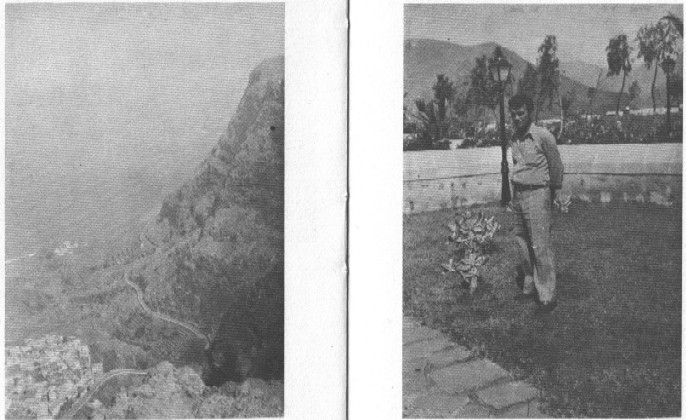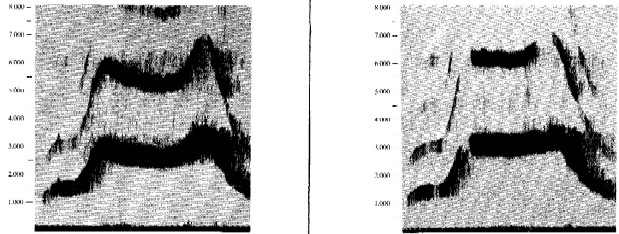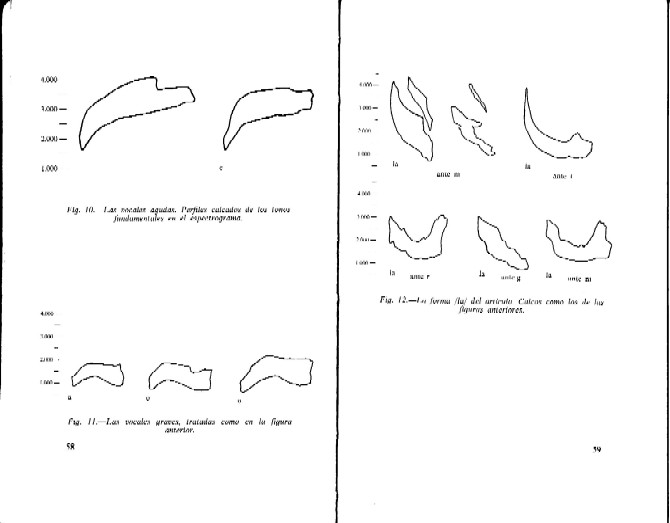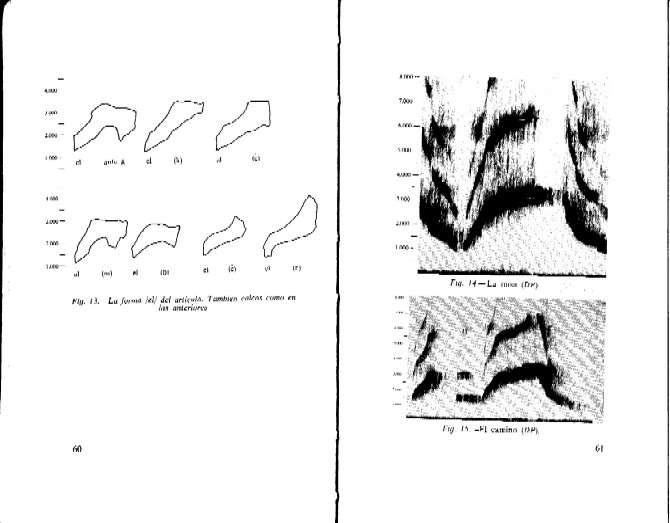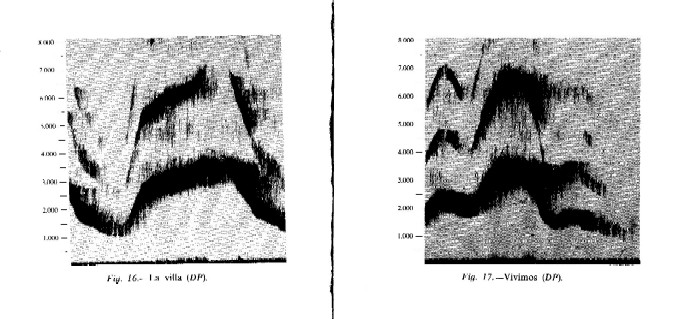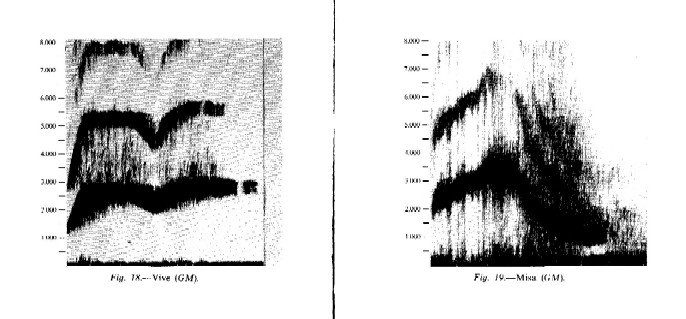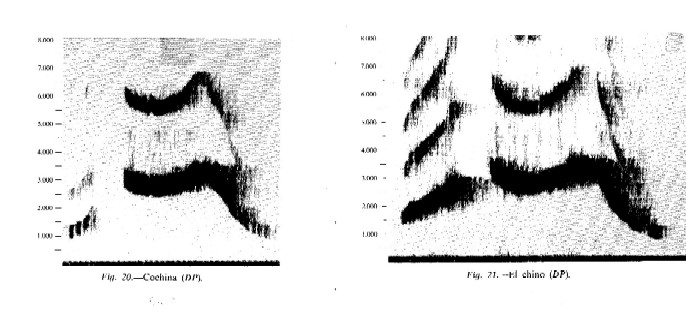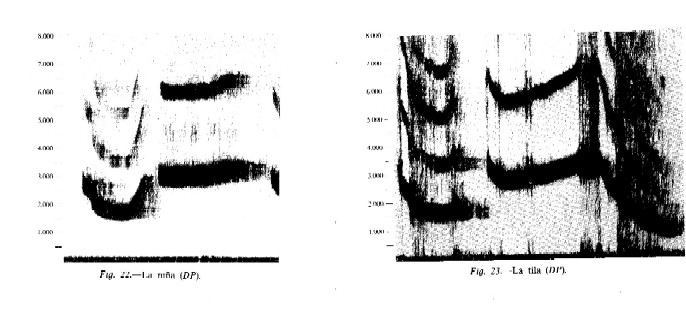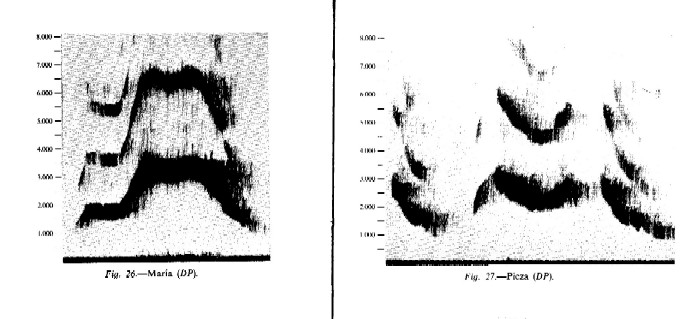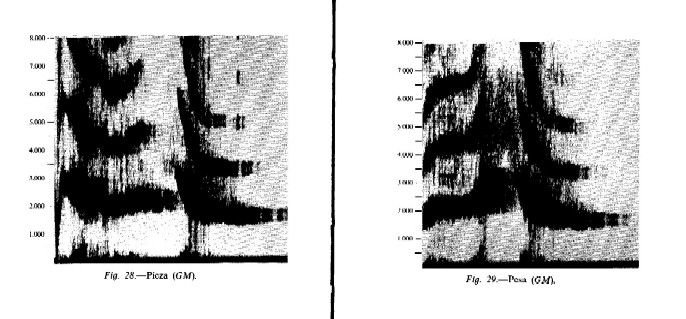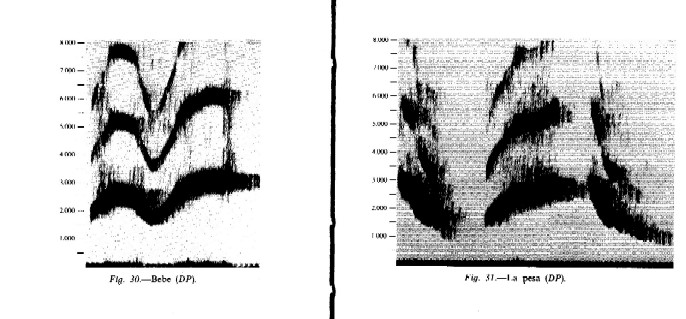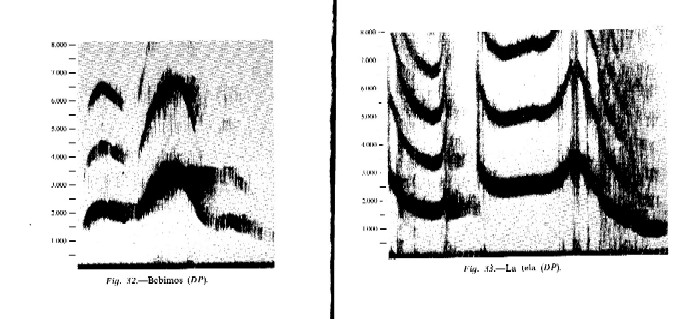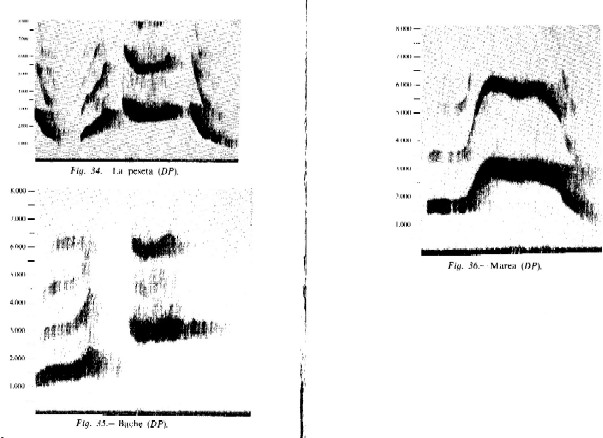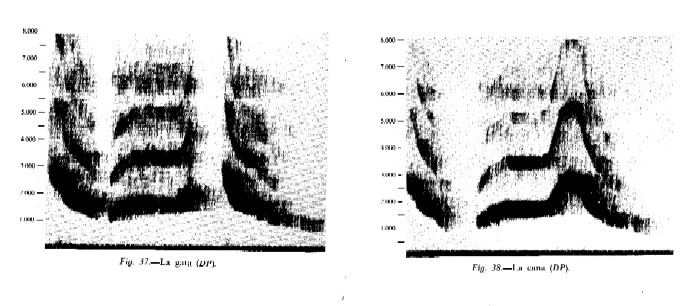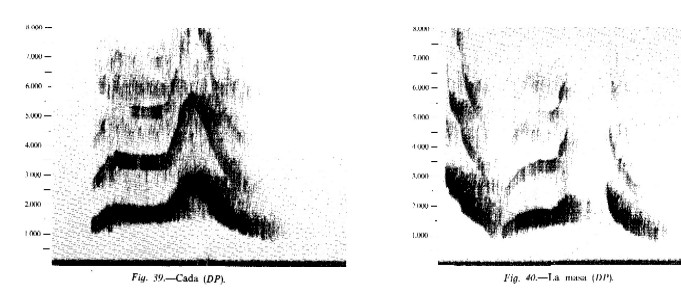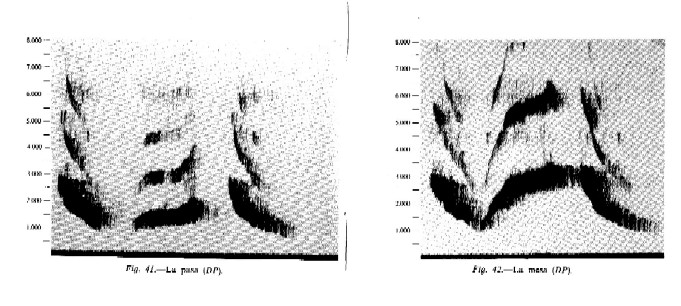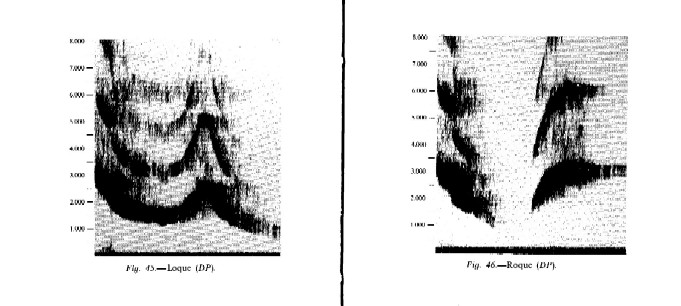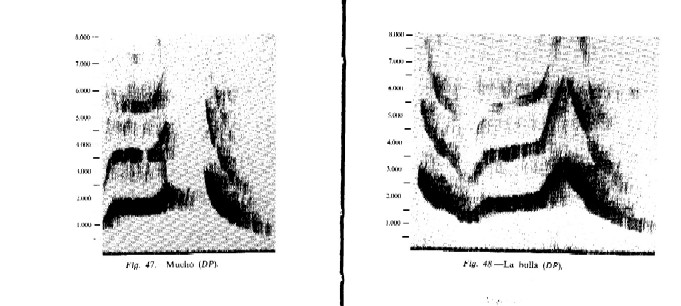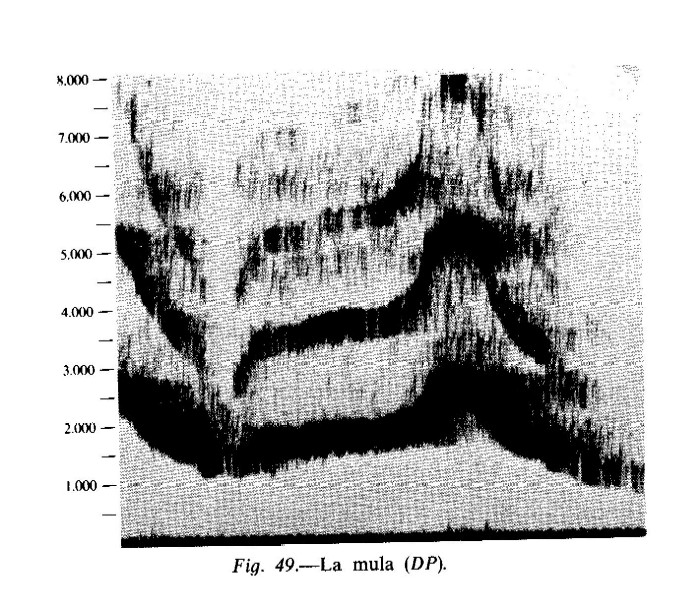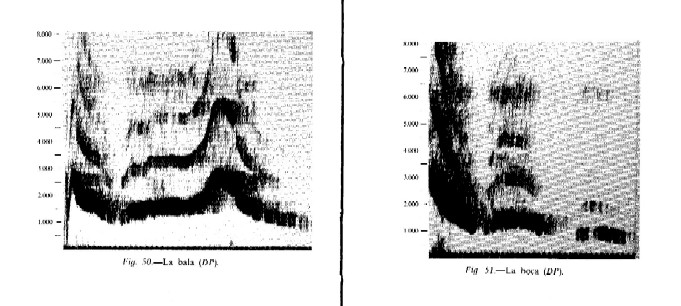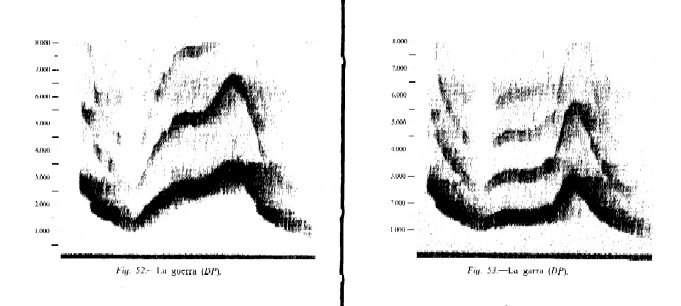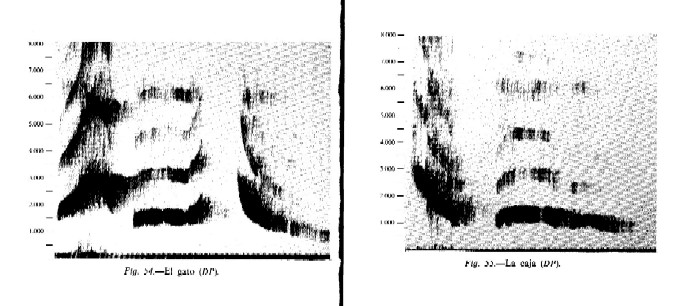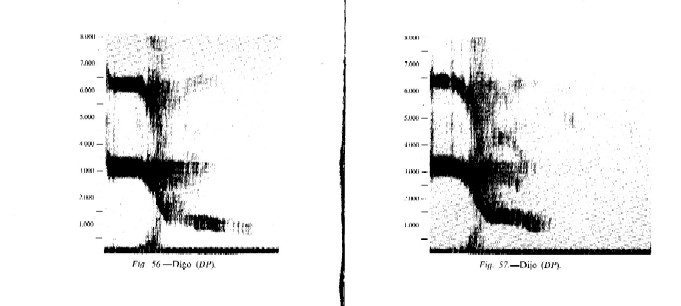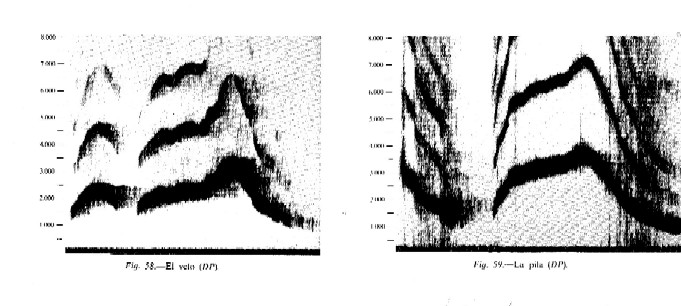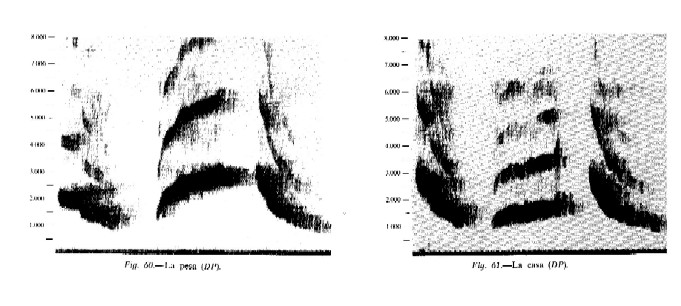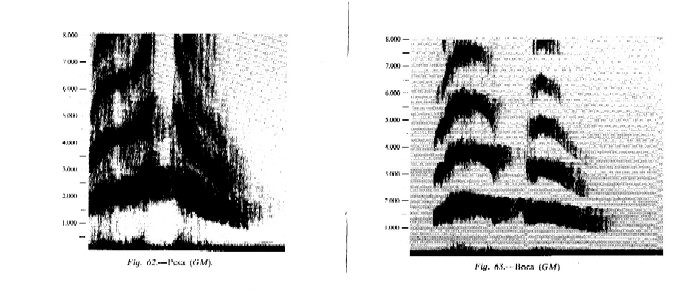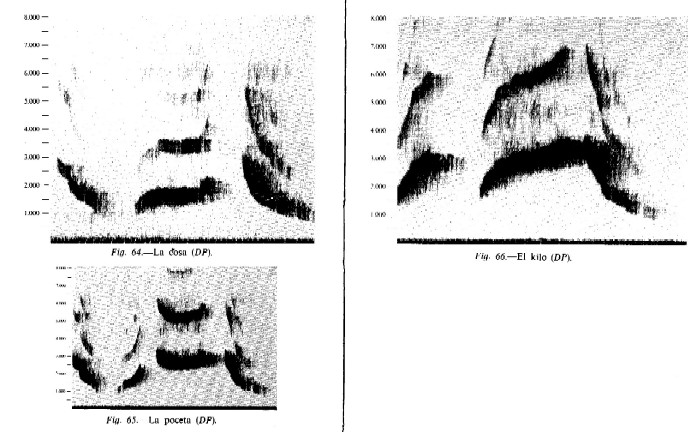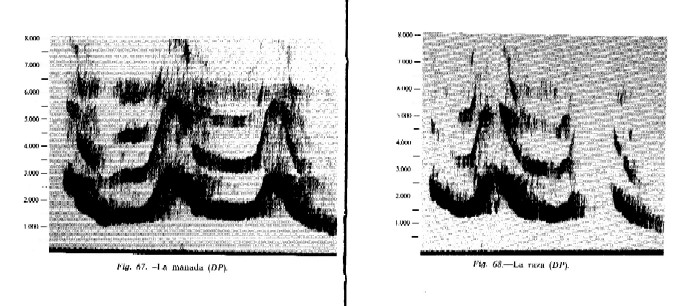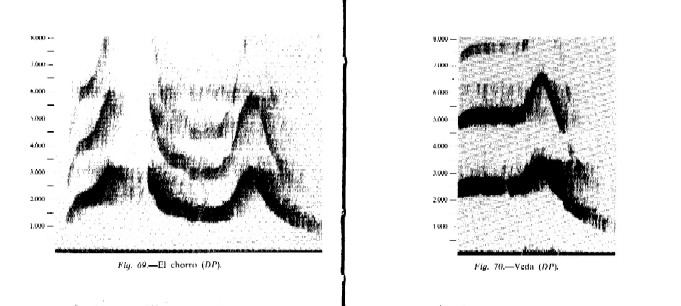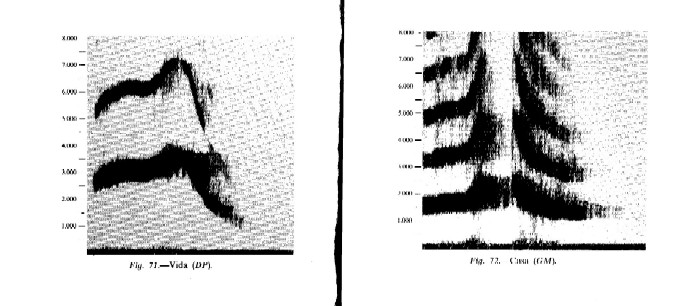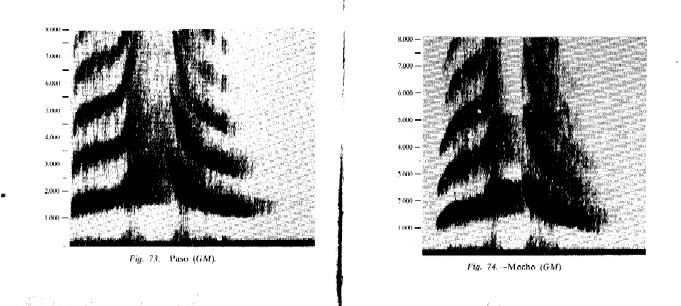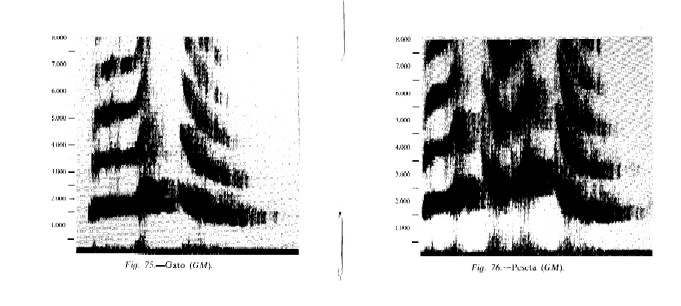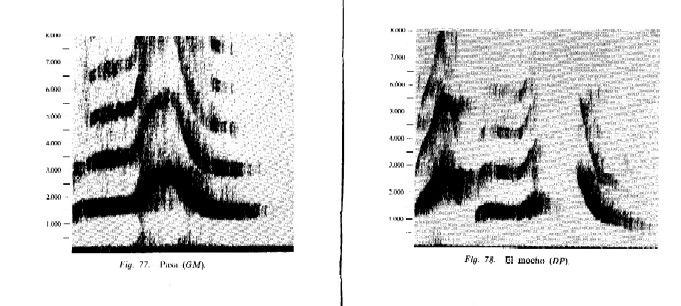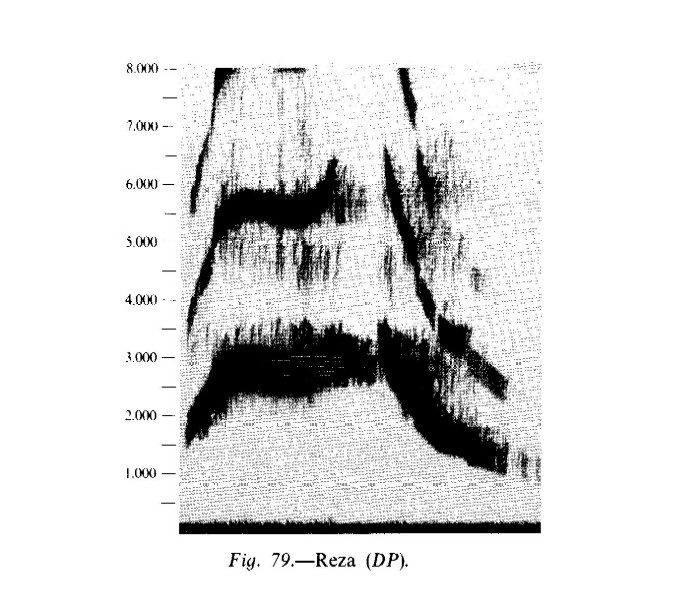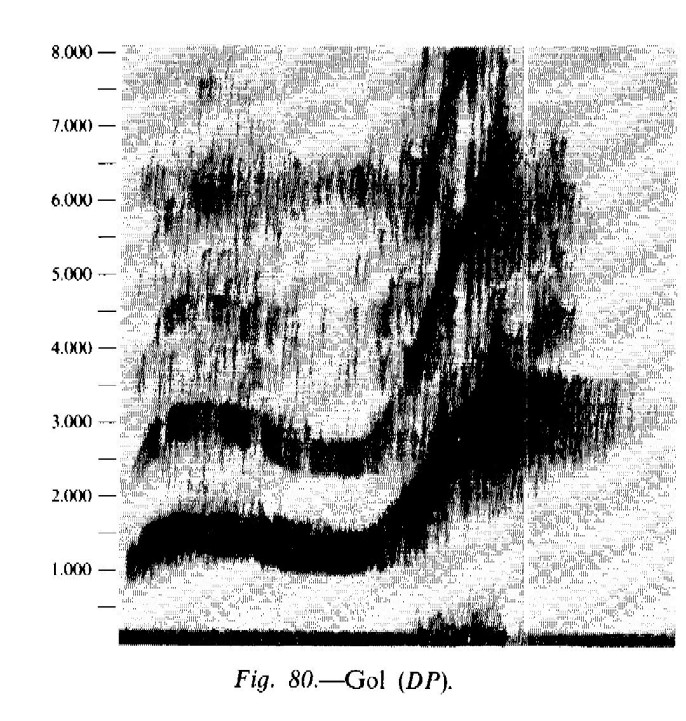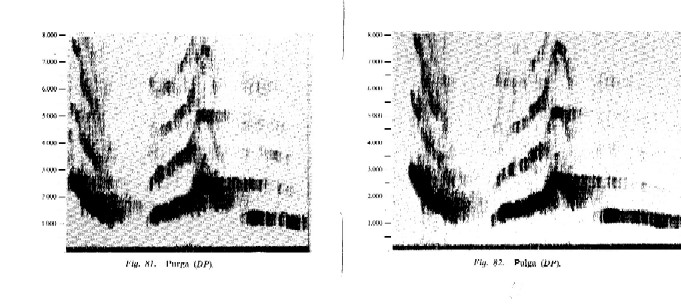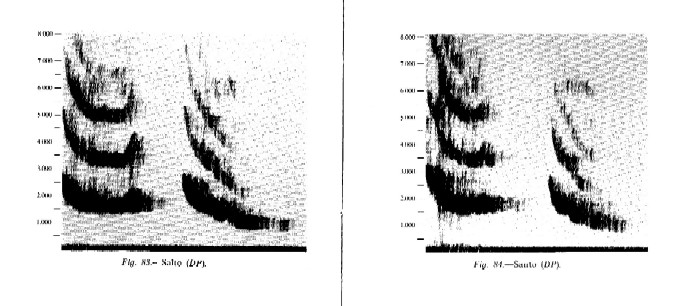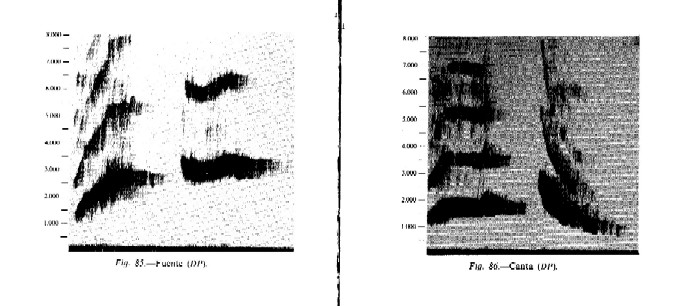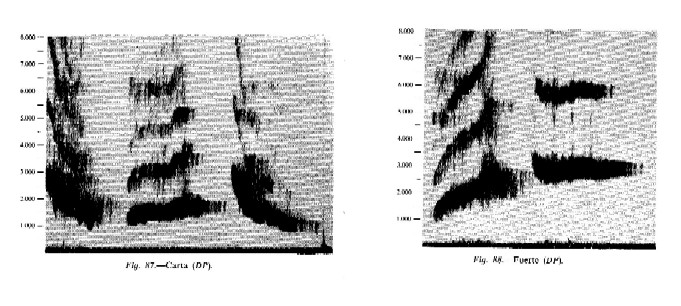|
RAMÓN TRUJILLO THE
GOMERAN WHISTLE (original
title: "EL SILBO GOMERO análisis lingüístico")
[original
book cover] Table of Contents
1 [The Author's Dedication to the Translator]
2 EDITORIAL
INTERINSULAR CANARIA FIRST EDITION,
DECEMBER 1978 © EDITORIAL INTERINSULAR CANARIA first edition
in Spanish printed by 3 4 [Translator's
Forward: The whistling language of La Gomera is truly a heritage of
mankind, and as such, Ramón Trujillo's fine treatment of this
phenomenal mode of communication is deserving of an edition in English.
I undertook this quixotic task to bring a greater understanding of the
Silbo Gomero whistled idiom to a broader audience. 5 GENERAL
CONSIDERATIONS ON THE Gomera is, without a doubt, one of the most beautiful islands of the Canarian Archipelago. And is, furthermore, the only one that preserves a truly singular pre-Hispanic custom, almost unique in the world: an articulated whistled language, about which enough pages have already been written, full, for the most part, of exaggerations, fantasies, and inexact observations. The island is small and mountainous to excess, and although it would be unwise to establish a direct link between the difficulties of communication caused by the mountainous geography and the invention of the Gomeran whistle, an authentic oral telegraph, it's certainly true that the roughness of the terrain and the lack of communication between the narrow valleys could have been important factors which helped to preserve this curious primitive mode of long-range communication there, a technique imported with almost absolute certainty from Africa by the first pre-Hispanic inhabitants. It may have also been the case, as can be inferred from different documents, that the technique of the whistle (Silbo Gomero) was more widely used in ancient times and finally it was La Gomera's special mountainous nature which made its conservation relatively easy.
6 Be that as it may, this is not a theme of much interest to a linguistic study. I believe that there are sufficient means for determining where it came from, as well as comparing it to other methods of whistling, which have already been known for a long time, and the majority of which, without doubt, have almost nothing in common with [the Silbo Gomero]. But themes of this type are always obscure, lacking proof, and the results of the research almost never conclusive. I prefer to leave matters which are beyond discussion and examine a certain number of sample illustrations, conscious that the margin of error is influenced by the corpus used. I do not attempt an exhaustive investigation, as all of the essential data is there and by definition inexhaustible. I go by the data in my possession: Here we have the Silbo Gomero which the Gomerans still practice; and that phenomenon, which is not a vague phantom of the past, rather an actual physical event which has been recorded by my instruments, will be the unique object of our attention. All the rest is legend, fantasy, and opinions of people long dead, etc. Which is to say, shadows of events, in any case non-events. The historian's job is to construct an interpretation with these shadowy documents of the past; ours is to report a physical set of sounds. 7 The linguistic interest of the Gomeran whistle is fundamentally rooted in the fact that it possesses, in imitation of natural languages, a doubly articulated structure, which separates it radically from systems of conventional signals, whose most notorious characteristic is the non-analyzable character of its significants in minor and constant units. This deals with an imitation called «double articulation» as understood by A. Martinet (1) and which had already been noted, as will be seen, by J. Lajard in 1891, R. Ricard (2) in 1932, and later repeated by A. Classe (3)(5) without citing either Ricard or O. Schmeider (4), who discovered it in the whistling language employed by the Tzapotec Indians. The Gomeran whistle has the basic structure of a natural language and serves as its substitute: this is where its interest lies. In the first place it presents itself to us as a mechanism of substitution, in special circumstances, of the Spanish spoken on the island and, at the same time, it turns out that this mechanism is not «conventional», rather it is elaborated on the same analytical foundations that all natural languages in the world use. In the second place such a mechanism is of capital interest to the science of sign language and, in general, to the sciences which study the problems of long-range communication and of simplified or, in other words, economized communication. Likewise for the Spanish linguist. In principle two types of problems can be posed: If one is to simplify the system because of the requirements of the emiting apparatus, a) what will be kept and what will be discarded? and b) to what degree will the criteria of omission be related to the less useful elements for the functioning of the Spanish phonological system? These questions and particularly the last one are of profound interest to whoever might inquire into the future of this language and its current trend of renewed interest. -----------------------------
*[Translator's Note: Unfortunately, the author was unaware at the time of this writing of the Busnel/Classe 1976 collaboration (5). Therefore, all mentions of Classe's investigations relate exclusively to the 1959 Spanish translation of reference 3 above.] 8 It must be admitted that the criteria of omission and conservation have been dictated by the form and structure of the emitting apparatus, and also that it's no less certain that what is conserved is correlated to phonological contrasts already exisiting in Spanish and translated almost exactly in the transpositions oral phoneme-whistled phoneme. Nevertheless, it so happens that the Gomeran whistle only permits differences in relative pitch (low/high) or relative differences in the continuous or discontinuous nature of the melody line (continuous/interrupted). For this reason, vowels, which in normal Spanish are differentiated on the basis of two contrasting criteria (dense/diffuse and low/high), find themselves here reduced to a single differential mechanism where the opposition between dense and diffuse is no longer possible, for there is only one resonator, in which the emitted wave is formed, that cannot undergo more modifications than this single resonator or the resonating chamber imprints on it. Out of necessity, the vowels have to be grouped at two extremes of a line: low-high. As will be seen, it is not consequently possible to establish other distinctions. The gradations, certainly physically possible, between those sufficiently distant limits of the "low" and "high" positions, do not turn out to be possible in practice, being modified in great measure by the variations of pitch which the relative inflections of the consonants impose. The contrast interrupted/continuous, which naturally has nothing to do with the vowels, is divided into two groups of consonants, which, in turn, and in the same manner as the spoken tongue, can be low or high, but not dense or diffuse. The consonants which are low in spoken Spanish are also low here, the highs occur in the same manner. The continuous ones do not change their quality, with the sole exception of /s/, which is presented in the Gomeran whistle as a high-interrupted, similar or equal to /t/ or /ch/. 9 The number of phonemes, therefore, is reduced in an almost brutal manner, but continues to have phonemes and not indivisible phonetic blocks: a whistled sequence, always a likeness of the other oral norm, will necessarily have to be analyzed in terms of phonemes, monemes and syntactic structures. The only thing preventing the whistle from being a distinct natural language is its substitutive nature: it is not a language, rather it is a transposing mechanism. In the same manner that one whistles Spanish, one could whistle Portuguese [or English], for example. 10 [blank] 11 THE QUESTIONNAIRE The inquiry that the conclusions are based on which we now present has been made with only a few subjects and we have decided not to appreciably augment their number because, save for small local differences —whose study is better suited to ethnologists and historians—, and personal habits, the results are always identical in what is essential with respect to a mechanism whose aim is communication. But even though there weren't many participants —not that it would have been any good if there were, since that would have only led to augmenting useless data to saturation—, the questionnaire prepared for the experiments, and applied in its totality on various occasions, is extraordinarily large and its application can take up to two full days of intensive work. The questionnaire consists of 904 items containing words, phrases and sentences that are at times very complicated, which had to be whistled by the participant and recorded on magnetic tape. 12 Naturally, the material used corresponds to the typical vocabulary of the Gomeran speakers and is arranged in such a manner that forms very similar to each other are opposed, so that the differential characteristics will always tend to make themselves evident for each successive simple element. It constantly insists on encountering and establishing the differences between messages which are phonologically very close: in essence, the subject is submitted to a system of phonological oppositions where said oppositions are made to border on the limits of confusion. In this manner and with extreme clarity we may determine that which is formal or differential and that which is accidental, merely physical and not pertinent. Effectively, this mechanism of the Gomeran whistle is double-articulated and therefore based on successions of minimal units which are opposed, so that according to the appearance of one or another in a given position, the distinct significant units will also be made evident. The words and monemes of the whistled langue, nevertheless, do not have the semantic precision of the significant units of the spoken language. In the Gomeran whistle, as we will see later, the problem is not polysemia —which is not a problem at any level—, rather that which in its place we will call polyphemia, and which consists of the fact that each «semantic» unit does not only have various meanings, but also represents a finite number of phonological words. The commutation, for example, of a high-interrupted consonant by a low-interrupted consonant gives rise to the perception of a complex phonic which is significant of a group of words each different to that which the former group, in which the commutation was practiced, would signify. Thus we don't understand why Classe affirms (pg 60 "Phonetics of the Silbo Gomero" 1956) that «The most striking feature of this peculiar mode of communication is that it does not seem to exhibit any oppositions that could be called phonemic as we usually understand the word: the transposition of one phoneticism into another does away with almost all phonological features». 13 This statement can only make sense if the author means that the elements in opposition are not «equal» to the phonemes of Spanish. If this isn't the case, we find ourselves in the presence of a defective understanding of the term phonetic opposition. 14 [blank] 15 REGISTRATION AND ANALYSIS OF THE DATA The phonic material, collected on magnetic tape, was later examined with oscilloscope and spectrograph. The results which the oscilloscope offers are not particularly useful and its analysis proved to be quite complicated. All that came to light in these experiments was the physical character that the Gomeran whistle possesses: here there are no formants composed of reinforced resonances in various resonating chambers, only a simple oscillation whose frequency may be raised or lowered; accompanied by its harmonics, quite visible, on the other hand, in the spectrographic representations. The advantage of the spectrograph and of the spectrograms is their graphic «clarity»; there we may see, with its frequency and irrelevant harmonics, the course followed by the whistled melody line; also its interruptions —measurable— and the exact form of the transitions which have been produced in the contacts between consonant and vowel or between vowel and vowel. We have preferred to use the so called wide-band in order to be clearer and more graphic, especially in this situation where small differences are totally lacking in significance. In figures 1, 2 and 3, we give three examples of the same specimen. 16 The first two [figures]
have the normal cut-off point of 8kHz (8,000 cycles per second): fig
1 in wide-band, and The use of the spectrograph for this type of analysis, where no complexities of the formants exist, may seem a little exaggerated. This is not the case, however. No other representation (with any guarantee of precision) gives the clarity of spectrograms of the Gomeran whistle; they are so clear that they prove to be almost ‹‹legible›› at first sight, especially from the moment that one has any familiarity with the nature of the whistled language. 17
Fig. 1 —"Mesa" [table], whistled by DP. Wide-band spectrogram. As can be seen, the spectrographic specimen is extremely expressive of the Gomeran whistle's melody line, represented by the lowest sequence. Above it appear the lines of the harmonics, multiples of the fundamental frequency. In this representation one can ‹‹see›› clearly how the melody line ascends rapidly from a low frequency to the level of a high vowel. The brief initial transition represents, then, a low consonant; and the more or less continuous line which is followed, above 2.4 kHz, a high vowel. Next comes an interruption, produced by an occlusion, and a steep descent from a very high frequency to 1 kHz immediately follows. The brusque interruption and subsequent descent represent, in the Gomeran whistle, a high-interrupted consonant. The final line signals the presence of a ‹‹low›› vowel. As we will see throughout this work, /s/ and /a/ are represented in such a manner in the mechanism of the whistled language. 18
Fig. 2 —The same emission as the previous figure, in narrow-band. 19
Fig. 3 —The same emission in wide-band spectrogram and with an amplitude of 16,000 cps, instead of the usual 8,000 cps.
20 [blank] 21 THE SUBJECTS As we said earlier, the number of subjects surveyed has not been higher than that used in similar works of a purely linguistic type. The most important specimens and those which have been recorded with precision equipment at the Parador National in San Sebastián originate from Mr Gilberto Mendoza Santos (fig 6) and from Mr Domingo Daris Padrón. The exceptional conditions under which it was possible for these recordings to take place are due to the infinite kindness of my friend and former fellow student, Mr Antonio Plasencia Trujillo, mayor of San Sebastián. Here is my acknowledgement to him. The two abovementioned whistlers are the most important in this work, being that only their recordings were capable of producing sufficiently clear spectrograms. Tapes recorded in the field have also been obtained, in various places around the island, however with imperfect equipment, typical of such places. Besides lacking quality and being full of extraneous noises, these specimens do not contribute anything new which proves to be essential for an exact understanding of the structure of the Gomeran whistle. Given, then, their merely supportive character, they were not used. 22 Important specimens were also recorded by Mr Domingo Martin Mesa and Mr Joaquin Herrera Sánchez. An hour and a half of recording time proved to be more than sufficient. From Mr Eliseo Correa Santos, in the vicinity of El Cedro, came on of our most interesting findings. We learned from him how any message which is formed with vocabulary know to the "silbadores" [whistlers], can be transmitted and received, though at times it's necessary to greatly multiply the redundancy of the message. Finally, a partial recording of the questionnaire was made at Las Rosas by Mr Olivier González Hernández and Mr Vicente Herrera Ramos (fig 7). Of the recordings used to obtain the spectrograms, it must be mentioned that Mr Gilberto Mendoza Santos whistles with one finger double between the teeth and that his whistle is strikingly powerful. Nevertheless, observing the spectrograms, the reader will be able to see how the zones of interruptions, [ie.] of silence usually have a fair amount of noise and that even in those cases where the interruptions appear to be totally clear, the preceding vowel tone is often prolonged until the consonant is reached. In contrast the ‹‹interruptions›› of Mr Darias Padrón are much clearer and almost always have a total silence, with rare exceptions of anterior vowel prolongation. It seems clear the presence of the fingers reduces the tension of the interruption, with a maintenance of the tone in the meantime. Since constant reference is made to Mr Gilberto Mendoza Santos and Mr Domingo Darias Padrón in the spectrographic specimens, we will use, for sake of convenience, the abbreviations (GM) for the former and (DP) for the latter. 23
Fig. 4 —The mountainous Gomera of the Whistling Language 24 & 25
Fig. 5 —Agulo, with its high peaks in the background Fig. 6 —Mr Gilberto Mendoza Santos, notable whistler 26
Fig. 7 —Mr Olivier González Hernández and Mr Vicente Herrera Ramos, whistlers 27 THE BIBLIOGRAPHY The existing bibliography on the Gomeran whistle is naturally scanty. I will not make a special review of it, but I will cite those which seem necessary to me. I must express, nevertheless, as one will see throughout these pages, the low opinion that I have about what has been done on this subject. At the end of the 19th century, J. Lajard speaks of a whistled language, used on La Gomera and El Hierro [Canary Islands], and initiates a summary description, and not an absurd one, of the technique of this mode of communication (1). It may already be perceived —compared to Quedenfeldt, for example (2)— that it is not a question of language founded on some basis alien to the norm, such as on a melodic structure or system of signals; rather [it is based] on an articulated language: It is nothing more than whistled Spanish, though with very limited possibilities as to communication. -----------------------------
28 Ancient mentions of the phenomenon are picturesque. Viera (1) and Abreu Galindo (2) make reference «to the common opinion that they were descendents of criminals» (3) deprived of their tongue for their crime. Both authors (4) make reference to the African character of the aboriginal Canarians language, pronounced «at the back of the throat» (Viera, par. cit). Viera notes, in any case, that the Gomerans «hardly appear to use the tongue for precise articulations» (ibid), this may signify more or less that their pre-Hispanic dialect differed from the other islands to some unknown extent. It is likely that the Gomerans —and perhaps others— had a whistled version of their own language, and that this rudimentary, but efficient, «telegraphic» technique, given its range in terrains of difficult accessibility, has managed to survive since its origin. If such a method of transmission was used for a primitive pre-Hispanic tongue now lost, it is possible that there was no great difficulty in adapting it to the language of the conquerors, especially in regions of limited communications. Samler Brown (5) affirms having heard a similar process of communication used by one of the tribes of the Atlas [Mountains], perhaps the missing link in the mysterious genealogy of the Gomeran whistle. -----------------------------
29 There are, however, two classes of whistled communication in the world: one "substituting" for a natural language —as occurs when writing, Morse code, etc—, of which the Gomeran whistle and the whistling language of the Tzapotec Indians, studied by O. Schmeider (op. cit.) and mentioned by R. Ricard (op. cit.), are representative. Based on Schmeider's work, Ricard draws the conclusion that the Tzapotec whistle —as with the Gomeran whistle and the whistled speech of El Hierro— does not constitute a special type of language: it is only a question of whistled Spanish or whistled Tzapotecan. Ricard, then, confirms Lajard's original hypothesis about the nature of the Gomeran whistle, similar, according to this data, to that of the Tzapotecan whistle. The other kind of whistle is conventional, which is to say, not a substitute for the natural tongue, and resembles all artificial systems of signals. These modes of communication abound in various parts of the world, but for the moment our aim is not, in the strict sense of the term, non-linguistic communication systems. In the same manner as Ricard's interpretation of Schmeider's assertion, André Classe (op. cit., pg 44, 1956) affirms that the Gomeran whistled language is the only[*] one in the world, "based not on prosodic but rather on purely articulatory features", which [Classe adds] does not discount the possibility that other examples of articulated whistles may exist based on the same criteria. Prof. Classe's abovementioned work is the only one that I'm familiar with which attempts a study of the Gomeran whistle with a certain seriousness (at least within the good doctor's capabilities). It is for this reason that a large part of this book is a detailed commentary of his [1956] monograph, followed by my personal conclusions, not only based upon objective data, but also upon long reflection about basic phonological facts, which, it seems, Classe had little knowledge of. *[qv. "Whistled Languages" 1976 - Busnel's studies of whistled Turkish at Kusköy, et al] 30 His "ear" on the other hand was not good, so he makes absurd contentions concerning the characteristics of the spoken Gomeran dialect, and all this, without even counting an inability to distinguish that which is phonological from that which is no more than simple phonetic fact, or that which is identical, grasping the Saussurian difference, so undoubtedly useful, between language and speech, which is still not completely appreciated by some. We can, however, excuse many of Classe's errors which are introduced into his work, and take advantage of some of the accurate observations which are in it, never forgetting that the bad will always bring the good to light. Classe's work, which, as we have said, is the only one that treats the problem at close range, will serve us as a constant reference, with its abundant observations, [which are] more accurate in the phonetic than in the phonological. And even if errors abound, usually those of the type previously mentioned, [it is still a] very good source of inspiration. In Classe's work there is, all things taken into consideration, a series of observations which are exact and incontrovertible. This is always taken into account. Before going on, we'd like to make it clear that our work does not attempt to resolve the genetic problem, neither does it try to clarify nor complete the bibliographical references to communications by means of whistled languages, which remain obscure to this day. Let us leave, then: The theme of its almost certain pre-Hispanic origin; The ruminations of the Gomeran whistle's adaptation to the Spanish of the conquistadors; And the problem of geographical considerations, [ie.] that these types of transmissions are only found in steep [mountainous] terrains, while they are unknown on plains and other flat places. None of the above will be the object of our present considerations. 31 From this point on, anecdotes aside, we will only be dealing with one fact: On the island of La Gomera a system of whistled language is still in use. We can thus disregard all those fantasies which historians are so fond of, and examine something with no element of fantasy: an authentic phenomenon, which we have been able to make numerous recordings of, and later carried out acoustic analyses on. The Gomeran whistle interests us only in that it is a true, living phenomenon; this is why we now leave the question of its conjecture-based history, whose solution does not concern us, forever. 32 [blank] 33 THE WHISTLE AND PHONETICS The whistling language used on the mountainous island of La Gomera is, without a doubt, a phenomenon which goes back to before the advent of modern communication. Even so, it is still alive and well, especially in the interior of the island. There are, depending on the region, several diverse «styles» of whistling and it is a fact, correctly observed by Classe, that silbadores from different regions have great difficulty understanding each other; and that others from the same area, and even of the same "school" —as I would say—, since it is a question of an imitative technique, can modify their general structure by adding certain characteristics, previously agreed upon between themselves, which permit them to establish —only among themselves— distinctions which the Gomeran whistle, as a general mechanism, is incapable of sustaining. It is a question, then, of «imitative» significants, non-arbitrary to the language they are a substitute for, and therefore capable of being «perfected» by the users. Reading Classe's work, it is lamentable that so much has been put in the hands of Gomeran whistle «virtuosos», who have been urged to make phonetic distinctions that, in fact, are not used and that no receptor could identify, precisely because these are not codified and only have a very specific conventional value. 34 Any of those whistlers would have difficulty deciphering complete whistled messages recorded even by himself after a certain time. The Spanish spoken on La Gomera does not have any notable peculiarities and has even fewer if we put it in relation to the whistle which on occasion substitutes for it. We find the same relaxed consonantism as on the other Canary Islands (tendency towards sonorization of voiceless interruptions, diminution of articulatory force in tense consonants, etc) and with non-distinct vowelization, as occurs in a great number of rural areas, in atonic position, especially in the initial and final [positions], giving rise to certain tendencies towards some types of neutralizing confluence which never manage to acquire a systematic value, as much because of the influence of the learned tongue as of the presence, however slight, of distinctive oppositions in those positions (1). Vowel confluence does not happen in tonic position, and the distinctions are clearly maintained. These are not transferred to the Gomeran whistle in any position, as will be seen, in the same manner as the majority of the consonantal distinctions; but not because of the abovementioned "relaxed" consonantism. According to Classe (op. cit., pg 51, 1956), the majority of confusion and ambiguities «are actually matched by similar confusions in the spoken language, and that without any noticeable detriment to intelligibility. For example, the fact that [r, l, n, ñ, ð] are identical in the Gomeran whistle is not likely to worry people who often confuse [r, l, n, ñ, ð] in their speech» (op. cit. pg 65). -----------------------------
35 What will the Gomerans say when they are informed by Dr. Classe that they are incapable of distinguishing between words such as cara [face], cala [cove], cana [gray hair], caña [cane], cada [each]? This is without a doubt a very grave error and I must confess it's hard to believe that a specialist could make such a statement, so obviously contrary to reality. While it's certainly true that the abovementioned consonants are confused in the whistled language, it is not because they are confused in the spoken language: Were this the case, the Gomeran dialect would no longer be a variety of Spanish, but an entirely different idiom. No less wide of the mark are Classe's affirmations, also relative to the phonetics of the Gomerna dialect, which deal with the phonemes /g/ and /ll/ (op. cit., pg 50, 1956). [Here he states that] the realization of the fricative /g/ «is very rare, I have seldom heard [santia{g}o] but rather [santiago]». Did Classe interview a German tourist by accident? Because no Gomeran would normally say this [santiago] which has been attributed to him, rather than the normal [santia{g}o]. Only one who knew nothing of phonetics or had never been to La Gomera could be ignorant of this. It would have been better if the translator (1959, Juan Régulo Perez) had warned the reader, so as to prevent the spread of something so mistaken and which is capable of greatly distorting the existing body of knowledge, among specialists, concerning the various Canarian dialects. But bad luck caused Professor Classe to make incomprehensible errors. According to him the phoneme /ll/ has fallen into disuse on La Gomera, the truth is that it is still conserved in a general manner, including its use among well-educated people who have studied a good deal in regions where /ll/ is pronounced as /y/ or /zh/ or /dzh/. Classe's phonetic observations on the Spanish spoken on La Gomera are, therefore, saddening. 36 Other observations of the same class, like the table of the phonetic system or the enumeration of sporadic dialecticisms, complete his information on the speech of the Gomerans. I do not want to add anything to them, because my conclusions about the nature of the Gomeran whistle show its independence with relation to local phonetic custom, in spite of Classe's insistence on searching for a link between one and the other. As we will see, that relationship doesn't exist, at least not in a clear and effective way. Regional varieties of the Gomeran whistle certainly exist, and rhythm and velocity may change considerably: The North, East and South of the island can be distinguished this way. But we aren't interested in such variations of the «art», because they are not significant to the comprehension of its structure, adding nothing relevant to the knowledge of the nature and form of the phenomenon. This is not a «manual» of the Gomeran whistle either. One can study the structure of the Gomeran whistled language without knowing how to whistle, in the same manner that one can whistle —and be whistled to— without a conscious knowledge of its phonological structure. What brings a phenomenon such as this to the attention of the linguist is based on two questions: Does it have the structure of a natural language or not? And if so, how can one verify the transposition of one linguistic system's units into those of a substitutive system? What is important to know is which elements or features assume pertinence and in what form they manifest themselves. For being certain, as is the case, that many phonemes are confused with others —and many more than Classe believes—, how does the synthesis work? What has been discarded? What has been kept? What has been transformed? There is no doubt that the problem is interesting for the phonologist who finds himself predisposed to think that if the necessity of dispensing with some of the elements of a system is presented, those elements endowed with 37 a minor functional capacity will tend to be omitted and those more useful will tend to be conserved. This supposition, however, requires clarification: Does this idiom have the structure of a natural language or not? Classe is correct on this point, affirming that «it is unique in being based not on prosodic but on purely articulatory features» (op. cit. pg 44, 1956); though that's certainly true, as we know, from what J. Lajard (1891), and Ricard (1932) had already written. 38 [blank] 39 NATURE OF THE WHISTLE The Gomeran whistle, then, is articulated in the sense given this term according to Martinet (op. cit.). This means that discourses can be divided into semantemes and these, in turn, into constant minor units that do not have any meaning per se, and thus only pertain to expression. Minor units, commutable between themselves, may be found in the Gomeran whistle, then, corresponding to the phonemes of the spoken language. It is precisely the fact that whistled messages can be broken down into semantic units, and those in turn into minor phonetic units, that generates its interest from the linguistic point of view, since it is not a system of indivisible signals, with communicative ends previously agreed upon, as occurs in the majority of known whistling languages. The Gomeran whistle is thus a simple mechanism that can potentially serve to emit an infinite number of enunciations, although from the circumstances, that we will presently be studying, we see that it is extraordinarily limited as regards comprehension, while not [limited] as to enunciation; which does not contradict its infinite possibilities, just as an infinity of possibilities exists in natural languages in spite of phenomena such as polysemia or syntactic ambiguity. 40 And that capacity is, of course, a consequence of the double articulation: in its own way, the Gomeran whistle has its semantemes and its phonemes, which is to say, significant components of successive and differential units which are commutable between themselves. What is the Gomeran whistle then? It is only a substitutive mechanism for the oral language, like writing, or Morse code, etc. Describing it graphically, one could say that it consists of a kind of «imitation» of the common tongue, and as regards its structure, it is evident that it lacks a distinct personality, in as much as it is only a question of a mechanism for the long-range transmission of the spoken language, whether dealing with one language or another. For this reason it is quite feasible that it served the prehistoric inhabitants to communicate among themselves in their native tongue and that it was later adapted to Spanish, as would have been possible to do with another language, although certainly with varying degrees of success depending on the complexity of the phonetic system for which it was necessary to substitute. It is, nevertheless, difficult to imagine it substituting for a language rich in vowels, considering that the Gomeran whistle does not allow for the emission of more than two [vowels]. It's quite possible that the original language had very few vowels; as is the case with Spanish to a certain degree, especially if you take into account the indistinct rendering of certain vowel oppositions in atonal position, particularly in the speech of poor or rustic peoples. If we add to this the «long» character of the Spanish word and the language's high level of redundancy, we will find that what we could term «primary Spanish» is very easily adapted to a substitutive mechanism extremely short on possibilities. 41 The Gomeran whistle is transposition. Each phoneme or group of phonemes has a correlated whistle. For all intents and purposes, save precise terminologies and the jumble of concepts used in linguistics, the whistled speech of La Gomera only posses six phonemes: two vowels and four consonants. The syllable is normally open and there are almost no implosive consonants, which reduces the number of phonic possibilities for forming syllables in a truly incredible manner. But nevertheless, communication is made possible, even given a certain complexity in the transmitted content: That which is directly confused by expressed phonological confluence, is primarily made up for by redundancy, especially in discourse, by adding new clarifying elements to the message until it becomes identifiable. And all this without counting the decisive role of the situation, which is also important in purely verbal communication. Sal! [Leave!] could be ambiguous if heard while passing by on the street, or from a window. but there could be no confusion if we heard it said by someone showing another person the door while pointing with his/her finger, or if heard from the mouth of a cook while taste-testing a dish.* Personally, what caused me to study the Gomeran whistle, knowing well that it was a simplified substitute for the spoken tongue, was the mistaken belief that faced with the necessity of reducing the system, the less efficient phonological elements and features would have to be eliminated, while conserving those with a high functional value. It has nothing to do with that: The syllabic nuclei, or «vowels», are «phonologically» reduced to two (high and low), even when the data collected shows a full gamut of rather varied phonetic or physical realizations and the pre-nuclear consonants are reduced to inflections or interruptions of the vowel's melody line. The confusion that this situation produces does not have the slightest relationship to the indices of normal functionality as regards the spoken tongue's phonemes: The Gomeran whistle's form is conditioned by the physical possibilities of the emitting mechanism, as we will see.
42 This phonic apparatus of great potential is described very well in Classe's 1956 article, along with common ways of using it. In order to achieve the necessary force, as well as to imitate and project the sounds of the oral language by means of whistling, the lips are immobilized and the anterior buccal cavity is used as a resonator/tone-generator, by bringing the tongue against the palate or the teeth or against one or two fingers. This anterior cavity serves as the sole resonator for the intense vibration of air constricted by the pressure of the tongue against one of the abovementioned parts. The technique used has no functional importance —whether with one finger, two fingers or fingerless, etc— as Classe points out (op. cit., pg 47, 1956), because all that these techniques affect is the average pitch level or overall volume, never its fundamental nature. In essence, it is a question of different «styles» of executing a technique. However the glottal vibration is stopped, as well as the sum of different resonating chambers, (also generators of different and simultaneous formants), the whistle, which emanates from one single source —lingual constriction— and which is generated in one sole chamber, consists exclusively of one simple [sinewave-like] tone (with all its harmonics clearly there, though lacking in information as they are periodical mathematical multiples of the fundamental frequency). There is no complexity from this point of view, then, and having the spectrograms shows us the limitless repetitions of a simple wave's harmonics. This fact was correctly observed by Classe (op. cit., pg 46, 1956), where he used an oscilloscope to examine these simple waves. 43 However, we have found the spectrograph to be much more useful, as mentioned. The «form» that the Gomeran whistle's melody line takes proves to be much easier to observe on the spectrograms: its frequency at each point, its interruptions, and their respective durations, etc [can all be clearly seen]. Only that some spectrograms turn out somewhat grotesque, without formants and with the monotonic repitition of the harmonics. But the latter is even useful. The graphic representation of each harmonic, as one sees in the many examples that illustrate this work, highlights each detail of the fundamental tone, exaggerating it, with the result that features which are scarcely perceptible in the fundamental's [melody] line, appear clearly exhibited in the second or third harmonic. It It must not be forgotten, furthermore, that the spectrograms which accompany this work are not mere illustrations, as I have just said, but are always «visible» proof of facts to which the contrary would prove disputable. In the spectrograms one sees there is no lower band, as the glottis does not intervene in the production of the whistle. The primary tone almost never appears below 1.0 kHz. A high consonant, on the other hand, followed by the substitute for /i/ can begin at up to 4.0 kHz. In spite of the fact that none of the Gomeran whistle's pitches usually appear above 4.0 kHz, we have decided to use a cut-off point of 8.0 kHz out of interest for the many harmonics shown. Finally, to establish the basic physical hypotheses of the whistle, it is convenient to clarify that the tone generating apparatus can only do two things: a) vary in size, and b) interrupt the emission. In the first case —a change in the cavity's size—, one can go from the smallest chamber used —a frequency in the neighborhood of 4.0 kHz—, to the largest —around 1.0 kHz— with a greater drop in the final distensions. In the second case —interruption of the melody line— there are only two possibilities: interrupted «phonemes» and continuous «phonemes». 44 It's clear that the possibilities of the first characteristic would be potentially very large since between 1.0 kHz and 4.0 kHz a rather considerable number of pertinent tonal distinctions could be established, given the great sensitivity of the human ear. But in reality this doesn't happen to be the case: all that is pertinent, despite Classe's assertion, is the high/low contrast, whereupon such a rudimentary differentiation gives gigantic margins of security. The high-vowel nucleus (which encompasses /e/ and /i/) practically never dips to below 2.5 kHz; while the upper limit, rarely reached, of /a, o, u/ never surpasses 2 kHz, and that such levels are attained when the melody line is "bent" upwards by a consonantal transition's effect. On the other hand, tonal variety remains, in fact, very limited in its effectiveness due to the pitch changes that the vowels' melody lines undergo by the effect of the consonantal transitions, since here, as in the spoken language, the transitions are indispensable to its perception. The Gomeran whistle consists of a series of melody lines that undergo ascents or descents over the course of time (the continuous consonants) or interruptions followed by an ascent or descent in the succeeding line (the interrupted consonants). Vowels and consonants are presented, in view of what a spectrogram examines, as lines where at times pitch remains level, at other times the pitch is altered: rising or falling or doing both successively, and at other times they are brusquely interrupted only to immediately continue on their course. 45 Due to the fact that what are called «vowels» in the Gomeran whistle are so subject to pitch modifications, as well as to our relative incapacity to distinguish absolute pitches, only the two most decidedly opposed extremes achieve a distinctive function, while the confused intermediate range has no significance, however much a whistler may take pains to distinguish vowels by their pitch. Vain effort: recordings that contain distinctions of this type (eg. /i/ vs /e/), are not identifiable, after some time, by even the same people who made the recordings and, of course, not by anyone else either, no matter how well they are acquainted with the Gomeran whistle. (This can be easily proven with isolated words or phrases where no clear clue is given by the situation or other circumstances.) 46 [blank] 47 THE VOWELS It's not impossible, nevertheless, that a clever researcher, coached by an expert virtuoso silbador, could manage to believe —along with his "maestro"— that such distinctions exist. The linguist has to be careful never to ask the person investigated for information on the structure of his language. Because, certainly, if one asks a silbador to distinguish between arena [sand] and harina [flour], he will attempt to do so and, from an exclusively physical, phonetic point of view, will succeed: In the spectrograms relative to these words (figures 8 and 9, which were whistled consecutively), we can see some 2.8 kHz for /e/ and 3.2 kHz for /i/. The silbador (DP) took great pains to differentiate what was asked of him, but, after a certain time, with no adequate context, he himself would be incapable of recognizing either of the two words in isolation, without contrasting them. The trouble is that a researcher may measure only physical events without checking their functional value: In the case that we've used for the example above, the difference is physically evident; «phonologically» it doesn't exist. The researcher has been deceived by the subject, innocently of course, which is the most deceiving. 48 Linguistic opinions on dialectal subjects —and such to that effect, which comes to the same— can be useful if good judgment is used, but are fatal if taken seriously. I believe that Classe was a victim of something like this. [He states that] «... vowels can be expressed with absolute precision. Consonants are another story » (op. cit., pg 56, 1956) Referring to the vowels /a, o, u/ which, for the purposes of the Gomeran whistle, we will call «low», he tells us that: «As in speech there may be in the case of these three vowels a degree of confusion: normally their pitches are arranged in descending order and [u] is hardly ever displaced ...» (op. cit., pg 54, 1956). «But [a] and [o] often overlap, when there is no possibility of confusion» (op. cit., pg 55, 1956). This is only true under artificial experimental condition, eg. having the subject whistle one vowel after the other. In figures 10 and 11, we show the simplified results of an experiment of this type: From the five phonological vowels of Spanish when whistled, we obtain, at the highest level (because they all show a very low initial transition, similar to a low consonant), 3.6 kHz and 3.2 kHz for /i/ and /e/ respectively, while /a, o, u/ are respectively at 1.8 kHz, 1.6 kHz and 1.6 kHz. If, as we will see throughout this study, some of the vowels undergo enormous modifications with respect to these values, while nevertheless maintaining a precise dividing line between the high and low groups, we come to the conclusion that such values are functionally identical among themselves, within each group, and that different vowels can only «be imitated» in isolation, ie. in a form in which they never appear. In effect, and we will also see this with clear examples, the differentiation between /a, o, u/ does not exist —not even when the silbador contends so—, in the same manner that no differentiation exist between /i/ and /e/. 49 In the section on consonants we will see that there are only «vowel» melody lines, low or high, that undergo very great modifications in their pitch level. The form that the article /la/ ["the", fem.] (fig 12) presents is quite eloquent, beginning above 4.0 kHz and with a rapid descent, over a period of 0.1 sec., to 1.6 kHz: the high consonant is presented as a brusque modification of the melody line. The form /el/ ["the", masc.], on the other hand, is presented as the reverse (fig 13): it starts out at 1.2 kHz and ascends almost to 3.0 kHz over a similar period of time: What is the /e/ here, and what is the /l/? The level of /e/ is reached, but coincides with that of the /l/ (1). It's evident that certain modification of the melody line have to be separated in analysis as different entities, which also have diverse functions, in the same way as in the oral language a certain modification in the formants of a vowel must be interpreted, for example like the consonant /p/, for otherwise one must give up considering it as a phoneme, since physically it is presented only as a vocalic alteration preceded by silence. It is evident that vocalic distinctions of Spanish cannot be expressed, in the Gomeran whistle, with the precision that Classe claims (op. cit., pg 56, 1956). There are no fixed or absolute pitches corresponding to these vowels, even though Classe asserts the contrary, even if only in final position and uniquely for /a, o, u/, an affirmation that completely contradicts the extensive data that I have regarding this. ----------------------------- (1) In the Gomeran whistle, nouns appear very strongly bound to the article, certainly as a single morpheme, the synthesis of the properly said and generated article. Many silbadores run into difficulties whistling isolated nouns, with no determinant. 50 We have already said that the vowel «substitutions» only allow differentiation of the most extreme oppositions, which is explainable, as we would suggest, as a result of the extreme variability of the vowel's melody line by means of alterations which we call consonants; as with the individual differences in the «art» of the Gomeran whistle, in which only the tonal extremes are rounded off, as much because of the recognition of a consonant (inflection), as for the recognition of a vowel (a sustained pitched tone with a variable time of 0.2 to 0.4 sec.). Certain syllables do not even present a sustained tone, rather they are permanently altered: an /i/ (fig 14), preceded by /m/, is seen beginning at a low starting point, characteristic of the consonant, with approximately 1.1 kHz, passing to 3.2 kHz and leveling off at 3.5 kHz. More than pertinent vowel tones, it's preferable to talk about what happens in reality where only extreme contrasts are distinguished, with the result that the «high» vowel (which is the transposition of /e/ and /i/) ranges, with all its consonantal alterations, from 2.5 kHz upwards, at least in its most «vocalic» part, which is to say, its sustained part; whereas the «low» vowel (transposition of /a, o, u/ is found below this pitch level. I have already discussed vowels pronounced in isolation and endeavoring to avoid confusion, with which it has been demonstrated how even so the only «real» differences exist between one low and one high. The whistled language of La Gomera possesses, therefore, two vowels. All else is fantasy derived from an incomplete observation of the occurrence of the vowels in their consonantal relationships, and the confusion between purely physical data and functional value. Functionality cannot be confused with physicality: A functional difference will always involve a «physical» difference; but physical differences, in such cases, do not necessarily involve functional differences. 51 We are now going to examine the results of the vocalic transpositions, along with their diverse consonantal relationships, never forgetting that the silbador is attempting to approximate as nearly as possible the distinctions of the oral language that he is trying to imitate. Effectively with the result that different mean vowel levels appear, that later the same silbador, without the help of the context could never distinguish between. It's for this reason that /i/ is always presented as a little higher than /e/, even when the difference would not be sufficiently large to perceive the distinction without the intervention of the context. For the high vowel, the approximate pitch levels are as
follows: The highest value that I have for /i/ reaches 3.8 kHz, at the moment preceding a transition towards /n/ (fig 15). The lowest value corresponding to the line of /i/ preceded by /b/ and followed by /ll/ (which is to say found between a low consonant and a high one), is only some 2.5 kHz, although the transition of the preceding consonant begins at 1.0 kHz, and the one following, to reach the high consonant, culminates at 3.2 kHz (fig 16). Something similar 52 occurs in the atonic /bi/ in vivimos [we live] (fig 17), with the consonantal starting point of some 1.3 kHz and vowel line of 2.3 kHz, with a duration of only 0.1 sec., which strongly contrasts with the following tonic /bí/, with a consonantal starting point at 1.9 kHz and a vowel line of 3.6 kHz. The duration of this tonic, however, does not exceed that of the preceding atonic. In figure 19, the /i/ of /mi/ is raised to 3.2 kHz, with a consonantal starting point of 1.7 kHz; and with the same subject (GM), the /bi/ in figure 18 is presented with a consonantal starting point of 1.2 kHz, with the vowel at a maximum of 2.8 kHz. With high consonants, are frequencies at 3 kHz, as in the /chi/ in figure 20, with a consonantal transition descending from 3.5 kHz with a very brief duration (0.05 sec.), all of it rather similar to that of figure 21. Lower values are found in figure 22, /ni/, with 2.7 kHz or with 2.8 kHz in the /ti/ of figure 23, as well as with the /si/ of figure 24. In the /ri/ of figure 25, nevertheless, it reaches 3.3 kHz after a consonantal inflection whose starting point is in the neighborhood of 3.5 kHz. In /ía/, with hiatus, /i/ maintains 3.5 kHz in the example of figure 26, with a transition time of 0.5 sec. to reach the 1.6 kHz of /a/. I also have an interesting example of [j]. In the example of of figure 27 (DP), the syllable [pjé], after starting with /p/ at 1.8 kHz, has the very steep ascent of [j] to 3.6 kHz, then drops rapidly to the normal vowel line's 2.4 kHz. Another very similar example by GM in the same syllable is seen in figure 28, clearly distinct from the /pe/ in figure 29. The presence of the «diphthongs», and many others that could easily be collected with no difficulty, will make one who reads these pages wonder if the opposition /i/-/e/ really exists. But we keep 53 coming back to this: It is not a question of clearly differential events. Semi-consonants and semi-vowels are easily confused, as will be seen, with implosive consonants or with liquid clusters: It's obvious that the Gomeran whistle can differentiate between /pe/ and /pje/, varying the initial infection of the vowel. What is not so obvious is whether one can differentiate between /pje/ and /ple/, for example. We may still continue maintaining that the [j] of [pje] is a modification of the high vowel, as also occurs with the implosive consonants, practically identical, in essence, to the vocoids which we have just seen. In any case, what happens is that these realizations, which are from vocalic phonemes of the spoken idiom, are found here fused with realization of the high continuous consonants. Finally, from what has been said up to now with respect to /i/, it turns out, using the same silbador, its pitch frequently shows values much lower thatn the highest median frequency of /e/. Further, the vocalic distinction does not exist because [i] or [j] will always take on a more or less brusque form of consonantal transition. The general «absolute» values for /e/ exhibit, naturally, lower averages [than /i/], without impeding crossing over into each other's respective «fields of dispersion», something that does not happen with the barrier existing between high and low [vowels]. After low consonants, /e/ is generally found between 3.1 and 3.0 kHz, while after high consonants the variation is usually situated between 2.08 kHz and 3.0 kHz. Nevetheless, after a low consonant, very low forms of /e/ abound. In figure 30, the tonic vowel of /be/ goes no higher than 2.7 kHz, while right next to it the same syllable, with an atonic vowel reaches 3.2 kHz, both with a consonantal starting point of 1.6 kHz. The /e/ of the /pe/ of figure 31, only attains a maximum of 2.6 kHz in spite of 54 it being followed by /s/. I even have an example —one sole— in which /e/ goes no higher than 2.2 kHz, as can be seen in figure 32. This is, certainly, a defective emission, which in all probability would be perceived as a low vowel, even when said low vowels do not normally exceed 2.0 kHz. After high consonants, the vowel line's average is a little lower: 2.8 kHz in /te/ (fig 33) or in /se/ (fig 34); in both cases with a consonantal starting point of 3.6 kHz and a brief transition time of 0.05 sec. But it may reach 3.2 kHz, as in /che/ (fig 35) or in /re/ (fig 8), and even to 3.5 kHz in the /re/ of figure 36. In the /éa/ of the same figure, it has 3.0 kHz, with a transition to /a/ at 1.5 kHz in only 0.05 sec. The article /el/ ["the", masc.], an important component of the whistle, is always presented as an ascending line traveling from 1.2 kHz to 3.2 kHz, with a duration of approximately 0.15 sec. I don't know in cases like those of the articles if one should simply speak of the vowel and consonant, or of something different, since on the other hand, these concepts have a very special value used in relation with the Gomeran whistle. Perhaps it would be better —in the case of the masculine definite article /el/— to speak of an «ascending vowel», since, as in other cases, a consonantal transition doesn't appear to be followed and it is well differentiated from a normal vowel line. Compared with this «ascending vowel», there is the other «descending» feminine form of the article (fig 12); perhaps the only important «morphemes» that exist in the Gomeran whistle. As regards the low vowels /a, o, u/, they are to be found reduced to one whistled vowel, whose pitch frequency is normally between 1.2 kHz and 1.8 kHz. Values higher than the latter are exceptional. It must not be forgotten that they never intrude into the domain of the high vowel, representative of /e, i/. 55 The vowel /a/ preceded by a low consonant may reach 1.8 kHz (figs 37, 38, 39), and even up to 1.9 kHz as in the /ma/ of figure 26, with a consonantal transition of 0.05 sec. from /m/. Preceded by a high consonant, it can be much lower, as in our examples in figures 40 and 41, both of /sa/ with 1.0 kHz or 1.2 kHz, as with the /ta/ of figure 34 and the /sa/ of figure 42. The /ta/ in figure 43 is notably high, with 1.7 kHz. The [feminine] article /la/, as we have seen, forms a descending line having a starting point which may begin at up to 4.0 kHz, and which doesn't usually start at less than 3.2 kHz. The descent falls to levels between 1.5 kHz and 1.2 kHz (fig 12). Whistled alone, /a/ normally reaches 1.5 kHz. The vowel /o/ fluctuates between 1.2 kHz and 1.6 kHz. It reaches 1.7 kHz in the /mo/ of figure 17, and curiously attains 2.0 kHz in the /to/ of figure 44. The differences that we pointed out with the behavior of the vowels with high and low consonants, do not prove to be so perceptible with /o, u/. Thus, we have 1.2 kHz in /lo/ (fig 45), or in /rro/ fig 46, as with the /mo/ in figure 32. Whistled alone, it will usually be found, like /a/, around 1.5 kHz. The examples of /u/ exhibit a median pitch level higher than that of /o/, and frequently [higher than that of] /a/. Thus, we have the 1.8 kHz of /mu/ (fig 47) or of /bu/ (fig 48), or the 1.5 kHz of the /mu/ in figure 49. 56 & 57
58 & 59
60 & 61
62 & 63
64 & 65
66 & 67
68 & 69
70 & 71
72 & 73
74 & 75
76 & 77
78 & 79
80 & 81
82 & 83
84 & 85
86 & 87
88 & 89
90 & 91
92 & 93
94
95 THE CONSONANTS In the Gomeran whistle, as will be seen, the number of consonants, contrary to Classe's conclusions, is reduced to four. The only possible distinctions are tonal —these are reduced to two extremes—, and the derivations of interrupting or prolonging the melody line. To be significant and notably brief we will call these consonants. We have, then, two contrasting pairs; low/high and interrupted/continuous. Any other distinctions which could be found are no more than mere phonetic artifact, void of significance. Thus, the following four consonants exist: "low-continuous", "low-interrupted", "high-continuous", and "high-interrupted". In the low-continuous, /m,b,f,g,h/ are confused; in the low-interrupted, /p,k/; in the high-continuous /n,ñ,l,ll,r,rr,d,y/; and in the high-interrupted /t,ch,s/. The /s/ is the only case where a transposition of interrupted [when whistled] for continuous [when spoken] occurs. As to the interrupted or continuous character of the rest, there are no alterations; just as there are none in the distinction between the low and high, which coincides exactly with the spoken word. 96 I do not wish to go into the theme of consonantal «modulations», without commenting on Classe's assertions, some of which are correct. In general, and as always, the majority of his errors stem from his obsession for differentiation to the extreme: which does not conform to the tremendous phonological poverty of the whistled language — for which only the articulating organs are responsible—, and he continually strives to search for and establish functional differences which do not and could not exist. In the first place the false problems of the point of occlusion is posed, when in the end experimentation shows us that it is question of something totally different from communicative intention of comprehension of what is heard. He says that «[f] and [x] are the same shape, but [f] is always "aspirate" and [x] "voiced as often as not» (pg 59, 1956). As will be seen, both phonemes are confused and this difference between "aspirate" and "voiced", which refers respectively to debilitated or non-debilitated emissions, is an absolutely irregular event and in no way significant. The same happens with /m,b/ and /b,g/, which is further confused by his obsession with the Gomerans' occlusive /g/. At times he is on the verge of being correct, but end up falling into the same error as always: «[p] and [k] are acoustically almost identical, except at close quarters. [p] is produced by a sudden interruption of the tone, the neighboring vowels being unaffected even at their limits» (pg 57, 1956). Had he not put in this «almost» or not spoken of "close quarters" or, of course, not added the serious error of the lack of inflection in the neighboring vowels, his observation of the acoustic identity [of [p] and [k]] would have been very astute, because effectively it is so. 97 He grasps the nature of the consonants which are high and establishes the radical difference between occlusive [consonants] of this type and the low [consonants] /p,k/. He errs seriously, nevertheless, when trying to differentiate between /t/ and the other high-interrupted consonants: «[ch] is articulated as in speech but further back; the silent interval is a good deal longer than in the case of [t]; the audible glide starts lower and is consequently shorter» (pgs 57/58, 1956). The question of this /ch/ which is articulated further back than in speech would not fail to have curious consequences, since this would cause it to be lower than /t/, something which is not certain, since both consonants appear in the Gomeran whistle at the same pitch level —fluctuating between 3.5 kHz and 3.6 kHz, with very rare exceptions which, on the other hand scarcely deviate from these values. With the difference between the /t/ and /s/ Classe comes close to being correct as to their identity, but ends up stating difference and confusing as always, the accidental with the essential «On closer examination —he affirms—, two major differences appear: (a) the pitch does not rise so much as for [t]; (b) the glides are less steep» (pg 59, 1956). Nothing could be further from the truth: the tone is frequently quite high, and as to the «glides», it all depends on the following vowel, exactly as happens with /t/. His observation that «Final consonants are rare» (pg 59, 1956) is not inexact, but he is mistaken in saying that «Only [r,l,n] are ever* whistled; then they are represented by their initial glide only» (ibid.) The use of «always*» is inexact, though it is not uncertain that it is sometimes heard. We'll come back to this. *[Trujillo worked exclusively with the Spanish translation of Classe's 1956 article (Juan Régulo Perez, 1959; La Laguna, Tenerife). It seems inexplicable that Trujillo chose not to use the English original for this work, but here (and possibly elsewhere) his misunderstanding is due to translation error: Classe's true statement "Only [r,l,n] are ever whistled ..." was translated as "Solamente se silban siempre [r,l,n] ..."; this makes Classe appear to say "only [r,l,n] are ALWAYS whistled ...", which is not what he meant at all.] 98 To accept all the different phonetics, whose number is naturally infinite, we would be obliged to catalog a number of consonants much greater than actually exists. We will examine them, therefore, going by our data and our spectrographic analyses, and we will group the phonemes of the spoken tongue under the heading of its four substitutes. The data would be falsified by anything else, even though it's true that the «virtuosity» of two or more whistlers, using an agreed upon system, could augment the precision —as can also be done with the spoken language by use of complementary gestures—, none of this affects the fundamental nature of this communicative instrument. We'll now examine the four whistled «consonants» in relation to their oral correlates.
THE LOW-CONTINUOUS The low-continuous consonant is always presented as a dip in frequency when between vowels, or as a «discontinuous» start in initial position or when the preceding vowel is so high that the fall is transformed into a hiatus. In any case, continuous or not, it is usually presented as a rise in its attack phase —and a dip in the preceding vowel's melody line—, though such a rise may prove to be imperceptible with very low emissions of the vowel. The «normal» level of these inflections are usually found between 1.1 kHz and 1.3 kHz at the lowest points, although cases of realizations above as well as below these values abound. Aside from possible questions of the whistler's «style», it all depends on the vowels preceding and following [the consonant] and on the volume at which the syllable is emitted. Consonantal starting points in the region of 1.1 kHz to 1.2 kHz are frequent, as in the initial [consonants] /mi/ (fig 14) and in /me/ (fig 1), with transitions that reach 3.2 kHz and 2.8 kHz respectively, 99 over period of 0.05 sec. The same happens with the continuous forms as in the me of figure 42 and the /ma/ of figure 40, with respective starting points of 1.1 kHz and 1.0 kHz, rising to 3.1 kHz in the case of /i/ and to 1.7 kHz in the case of /a/. The /b/ is also presented in low forms: the /bi/ of figure 16 is seen as an ascent of 1.0 kHz to 3.2 kHz; the /ba/ of figure 50 as 1.0 kHz to 1.4 kHz; the /bu/ of figure 48 as 1.0 kHz 1.8 kHz; the /bo/ of figure 51 as an ascent of 900 Hz to 1.2 kHz. The /g/ behaves in the same manner: the /ge/ of figure 52 is seen as an ascent of 1.2 jHz to 2.5 kHz; the /ga/ of figure 53 as 1.2 kHz to 1.6 kHz. In figure 54 the /ga/ appears as an «interrupted» continuous, with a very subtle transition of 1.2 kHz to 1.35 kHz. The /h/ is scarcely visible in figure 55, where the form /ha/ is only seen as a descending vowel line (1.5 kHz to 1.2 kHz), occurring over a total duration of 0.5 sec. The difference between /g/ and /h/, which does not exist functionally, is well illustrated by figures 56 and 57. When combinative circumstances require, the starting point of the consonantal transition may be rather high, although what is pertinent in the transition is precisely its ascending form. Thus, the /mo/ after /i/ in figure 32, is seen as an ascent of 1.5 kHz to 1.6 kHz; the initial /be/ of the same figure as 1.6 kHz to 2.3 kHz; the non-initial /bi/ of the same figure as 1.6 kHz to 3.2 kHz; and the non-initial /be/ of figure 58 with exactly the same form [as initial /be/ of figure 32]. The /ga/ of figure 53 is seen as an ascent of 1.2 kHz to 1.6 kHz and the /ge/ of figure 52 as 1.2 kHz to 2.5 kHz. Therefore, in the regions of the high vowels as well as in those of the lows, the realizations of the group of consonants /m,b,f,g,h/ overlap in a more or less arbitrary form —not taking into account the influence of the surrounding elements—, so that no phonological or phonetical criteria exists in the Gomeran whistle that 100 could establish the precise differences which these consonants establish in normal speech. It can be affirmed, beyond a shadow of a doubt, that all these consonants are reduced to one sole in whistled language, with great phonetic variety, but without the possibility of differentiating between them in a clear and constant manner. This is why we group the entire set under the heading of «low-continuous consonant»: the only features that remain common, as we have just seen, and which differentiate the entire set from those other [sets] which include the rest of the consonants of the spoken language. There is never a case where the same phoneme of the spoken language seeks its equivalent in the context of two consonants whistled differently. Which is to say that [the set] /m,b,f,g,h/ is opposed, as one and the same thing, to other «phoneme-sets» /p,k/, /n,ñ, l, ll, y, rr, r, d/ and /t,ch,s/.
THE LOW-INTERRUPTED The low-interrupted consonant includes only two oral consonants: /p,k/, whose acoustic semblance Classe pointed out, although later he tried to search for appreciable difference between the two (op, cit. pg 57, 1956). Those differences, nevertheless, exist only on an exclusively physical plane, and, as is natural, their realizations overlap chaotically. Both /p/ and /k/ have a starting point which may vary from 1.0 kHz to 1.5 kHz according to the vocalic contour, the volume, etc, as is always the case. Thus, the /pi/ of figure 59 is seen as an ascent of 1.3 kHz to 3.2 kHz; the /pe/ of figure 60 as 1.2 kHz to 3.0 kHz, similar to the /pe/ of GM in figure 62. The /pa/ of figure figure 41 is seen as an ascent of 1.0 kHz to 1.6 kHz, almost identical to the /ka/ of figure 61, seen as an ascent of 1.1 kHz 101 to 1.6 kHz or to that of figure 63, whistled by GM, with an ascent of 1.1 kHz to 1.5kHz, and similar to the /ko/ of figure 64 which ascends from 1.0 kHz to 1.6 kHz. The /po/ of figure 65 is almsot the same with its ascent of 1.0 kHz to 1.5 kHz. Compare the /ka/ in figure 15 (no variation - 1.5 kHz to 1.5 kHz) with the /ka/ of figure 51 (800 Hz to 900 Hz). The consonantal starting point may be rather high under favorable circumstances as with the /ke/ in fig 46 (1.6 kHz to 3.0 kHz) or with the /ki/ in figure 66 (1.6 kHz to 3.2 kHz). It comes down to the same thing: an indeterminate fluctuation as regards the distinction between /p/ and /k/, but the low occlusive group is clearly distinguished from the other groups, The normal form of these consonants, if one observes the illustrations, is that of an ascending inflection after a silence, as opposed to the continuous [consonants], which, save for the exceptions mentioned, are presented as a dip (descending-ascending inflection) in the surrounding vowel tone. Both low-interrupted consonants are presented in the spectrograms, more or less, as in the following diagrams (especially if the preceding and succeeding vowel levels are low):
THE HIGH-CONTINUOUS The high-continuous consonant of the Gomeran whistle is the acoustic signal which comprises the most consonants of the idiom: /n,ñ,l,ll,rr,r,d/. The distinction between the interrupted [d] and the fricative [ð], that Classe gets stuck on, is totally irrelevant, since, as we have seen, a continuous [consonant] can appear preceded by the phonetic characteristics of an occlusion, both when it is an absolute initial, as well as when found after a very steep transition. 102 The consonant which we'll now examine is the one that carries the major part of the Gomeran whistle's ambiguity, since, in spite of Classe's affirmations concerning the confusion in the Gomeran dialect between the elements of this set (op. cit. pg 51, 1956), this ample gamut of alveolars, dentals, and palatals are all distinguished —and not with any less precision than in any other part— in the Gomeran speech. We have been unable to verify even the occasional distinction that Classe finds at times between /ñ/ and /n/ as a systematic occurrence. The high-continuous consonant has the same form as the corresponding low-continuous consonant, but with an inverted curve, so that in this case it first rises and then falls, in intervocalic position, though in a manner more manifest than the inflection of the low [consonants]. Diagrammatically, the high-continuous and high-interrupted consonants have, approximately, the following forms:
103 and the /orro/ of figure 69 with 1.5 kHz to 3.2 kHz to 1.2 kHz (1). Neither does the [high consonant] in the /ari/ of figure 9 exceed 3.2 kHz with its sequence of 1.7 kHz to 3.2 kHz to 3.5 kHz, with a brief interruption between /r/ and /i/. High forms abound. The /ani/ of figure 22 has the form 1.7 kHz to 3.6 kHz to 2.7 kHz, and the /illa/ of figure 16 with the form 3.2 kHz to 3.6 kHz to 2.0 kHz. The /era/ of figure 52 has the form 2.6 kHz to 3.6 kHz to 1.2 kHz. The /d/ is always presented at a very high level. In the /eda/ of figure 70 it takes the form 2.8 kHz to 3.6 kHz to 2.0 kHz and in the /ida/ of figure 71 with 3.2 kHz to 4.0 kHz to 2.3 kHz. It is clear, then, that the high-continuous [consonant] presents margins within which the variability is large and multi-faceted, and which does not permit making direct conclusions to establish functional differences between the distinct magnitudes.
The high-interrupted consonant, which acts a substitute for /t,ch,s/, is presented as a steep descent, more or less as a function of the surrounding vowels. The high-interrupted [consonant] is presented, then, in the form of an ascending transition in the preceding vowel (quite large if said vowel is low, and very small or almost imperceptible when [the vowel] is high), followed by a comparatively large interruption, after which the descent of the consonantal ----------------------------- (1) Contrary to our treatment of the low consonants, here we note the entire vocalic contour of each high consonant, since with such distinctions it appears to be the only form which clearly shows the total course of the consonant.
104 transition begins. The difference in the duration of the occlusion is always circumstantial, and does not serve to establish distinctions between these consonants. It must be noted, nevertheless, that the clarity of the occlusion is quite variable. DP, who whistles without fingers, denotes the interruptions with a good deal of clarity, even when the preceding melody line is at times extended to the beginning of the consonant. Nevertheless, it often happens that a tone is maintained throughout the brusque occlusive impulse. The recordings made by GM, who whistles with one finger, show great prolongations of the vowel line to the point of running into the descending transition of the consonant, which on occasion proves confusing. This also occurs with /t,ch,s/. In these cases, the interruptions may better be observed in the harmonics, which exaggerate the contours of the lines. GM's /s/ in both figures 72 and 73 do not prove to be very obscure. But /t/ and /ch/ also approach parts of the vocalic melody line without ever abandoning the entirety of the occlusive separation, as can be seen in figures 74, 75 and 76 (GM). At times we are confronted with the unfortunate realizations where an interrupted [consonant] is confused with the corresponding continuous [consonant], as happens in the example in figure 77. Classe tries to differentiate between /t/ and /ch/, attributing a longer duration to [the interruption] of the latter; «the silent interval is a good deal longer than in the case of [t]» (op. cit. pg 57, 1956). This is an error which contradicts the data we possess, for while /t/ (qv. figures 23, 33, 43), as well as the majority of the examples of /s/, are presented as an interruption of some 0.1 sec., our /ch/ is presented throughout having the same value, save perhaps for an exceptional case. Thus the /ch/ in the /cho/ of figures 69 and 78, in the same way as that of 105 the /chi/ in figure 21 and the /che/ in figure 35 all have an interruption with a duration of 0.1 sec. The /cho/ of figure 47 is equal to 0.12 sec. Classe's hypothesis on the phonological value of the distinct durations of the occlusion, as can be seen, is totally baseless. More striking are the interruptions of 0.13 sec. of the /k/ in figure 46 or that of figure 44 with a silence of 0.15 sec. What is certain is that to the ear they all have a hissing sound after the occlusion. The mean level of this high-interrupted consonant is approximately 1.7 kHz, although they are frequently found from 3.5 kHz and (yet less) to 4.0 kHz. The /t/ of figure 33 starts at 3.6 kHz and that of figure 43 at 3.5 kHz, while the /to/ of figures 44 and 54 are found at lower frequencies, undoubtedly due to combinative causes. Due to the same causes, the /ti/ of figure 23 is at 4.0 kHz. The /s/ is presented at similar levels after the interruption, which, as in the other cases, commonly lasts approximately 0.1 sec. The /s/ of the /sa/ in figure 42 starts at 3.5 kHz and that of figure 79 at 3.7 kHz, compared with the 3.6 kHz starting points of the /se/ of figure 34 and the /so/ of figure 73. The /chi/ in figure 21 is at 3.6 kHz, but the /cho/ of figures 47 and 69 does not exceed 3.2 kHz. We could give more examples, but we would always find that with the limits that the spoken language maintains between /t, ch, s/ they are confused here in an absolute manner. 106 & 107
108 & 109
110 & 111
112 & 113
114 & 115
116 & 117
118 & 119
120 & 121
122 & 123
124 & 125
126 & 127
128 & 129
130 & 131
132 & 133
134
135 IMPLOSIVE CONSONANTS The implosive and final consonant of the word is quite rare. We have some examples of a final consonant. The final /l/ of figure figure 80, which starts from an /o/ at some 1.2 kHz, ascends, over a duration of 0.15 sec., to 4.0 kHz. The interior implosives /r/ and /l/, though equal, appear frequently, as we already know. They are perfectly visible in purga [purge] (fig 81) and in pulga [flea] (fig 82), with the double transition, ascending and descending, [characteristic] of these high-continuous consonants, [which is] followed by a small jump to the low levels of /g/. In the /l/ of salto [jump] (fig 83) one scarcely notes the beginning of the ascent at the end of /a/, preceded by the occlusion. Nevertheless, there is no trace of the implosive /n/ in santo [saint (masc)] (fig 84), where perhaps a small syllabic compensation with the occlusion of /t/ of more than 0.15 sec. remains. Neither is there any trace [of /n/] in canta [s/he sings] (fig 86). The /r/ and /l/ are always more visible. Of the latter [implosives /r/ and /l/], that of carta [letter] (fig 87) and that of fuerte [strong] (fig 88) are clear. In any case, the implosives /l,r,n/ are also not distinguished, in a definite or clear manner, from the semivowel [i], as in the instance of the diphthong [ai] (fig 89). 136 Considerations of interest as to the accent and accented rhythm of the spoken language, is beyond the scope of this book. The Gomeran whistle clearly has its own rhythm, but differences of strength are not relevant for obvious reasons and the differences of level are closely linked to the phonological structure. To say, for example, that the tonic syllable is at times higher, besides not being certain, would imply ignorance that the differences of level are almost always phonemic, apart from that the same events would prove to be contradictory in this respect. Thus, for example, the tonic syllable of bebe [s/he drinks] (fig 30), being structurally equal to the atonic, proves to be lower (2.7 kHz) than the other (3.2 kHz), and of course less intense, as the "reflections" of the harmonics appear to reveal. 137
138 & 139
140 & 141
142 & 143
144 & 145
146
147 «POLYPHONEMIA» With these six phonological substitutes, which we have rapidly analyzed (for it would be uselss to reiterate to saturation events which occur in an invariable manner), the Gomeran silbadores emit their messages. It has always been said that with such means one may only transmit very elemental things, based on a very sparse vocabulary and, of course, in situations where there is never any doubt about what one wishes to say. In other words: The whistled message is totally foreseeable and for that reason, understood. This is, nevertheless, not certain. There is no doubt that, both in the spoken language as well as in its whistled substitute, a "foreseeable" message will be understood more easily than one which is not foreseeable, and no one can ignore the role which the situation plays in the interpretation of the entire message. But none of this takes place here. There is no doubt that the mechanism of the Gomeran whistle is more precarious than that of the idiom which it substitutes for, but neither can there be any doubt either in that which refers to the nature of the Gomeran whistle itself as such. We have already stated that it is not a distinct language, rather a substitutive mechanism which nevertheless has the peculiarity of being 148 constructed on the fundamental quality of natural languages — double articulation— and which distinguishes it from sign languages and other [conventional systems]. In the same manner as any natural language, the Gomeran whistle can transmit any message: the difference rests on [the fact that] the difficulties of deciphering it may be augmented immeasurably. A phrase in the spoken language can present various degrees of polysemia, but this will never be as great as that which its whistled likeness suffers. Because here a major factor intervenes, which resembles (but is not exactly identical to) linguistic polysemia. In effect, any given word can have two or more meanings —which is to say it may be a significant of distinct characters—, but without posing serious problems to interpretation thanks to the presence of distributive and/or combinative "symbols", call them what you like. The simple use and simple usage of the traditional example will never offer interpretive problems, since it is always a question of distinct characters, clearly distinguished in its semantic limits by combinative events. That of the Gomeran whistle, on the other hand, is not polysemia in this sense: it deals with functionally phonological outlines —in the sense that they are made up of elements opposable between themselves by means of distinct phonic features— with the peculiarity that each one allows a series, always finite, of natural transposed phonemes, in each position. If we represent the six elements of the Gomeran whistle with the following symbols, then:
149 It's evident that the number of phonological words —not [the number of] semantic [words]— that the expressed outline may represent is very large, but not infinite, which is to say that this mechanism does not «obliterate» the lexicon, but, on the contrary, is presented in the form of sets of phonolexical possibilities.There is no polysemia, then rather, polyphonemia, which is not present in [other] substitutive systems such as Morse code, which it has proven comparable to. Polyphonemia signifies that a whistled word is not the same as a word in the spoken language, and not even its substitute, rather a formal component, representative of a certain number of lexical elements. It is a formal component of a language by aleatory definition, but it is not «defective» or primitive: the whistled word is unique in an absolute manner, for it is differentiated from others by significant functional features. Semantically it is also a differentiated unit, with the particularity that its meaning is a list not arranged according to any principle: each one represents a group which may be opposed to and differentiated from the others. Naturally, the immediate consequence consists of the necessity of augmenting the redundancy of the message in order to complement the circumstantial information, ie. to put the suitable semantic entities of each phonic word in place, But this is a task for the talent and skill of those who already use the Gomeran whistle: it is the world of speech, as Saussure said, or of performance, as it is called in accordance with other modes. From the essential point of view, the message is perfect when its units and connections are good: attributing a meaning in a given situation is not the material of a true science; at most, [it is the material] of a scholarly discipline, the commentary of textbooks, a kind of didactic gymnastics, which is as necessary as useful in all apprenticeships in the sciences 150 whose object is man and his works. Nevertheless, it has nothing to do with the science of meaning, since that does exist: what we call such are the distinct interpretations that we give to a formal structure of language, of the type that this is. For that matter, nothing could be more mistaken than the rather generalized idea that the Gomeran whistle is only used for communication things more or less well-known. My experiences in San Sebastián and Agulo, in particular, showed me quite clearly that the non-familiar and even totally unexpected messages can be transmitted and received. When all is said and done, the insurmountable obstacle is ignorance of a given word, something which also happens in the spoken language. When the message becomes too obscure, due to what we have called polyphonemia, circumlocution begins, at times to a rather large extent, until communication is finally established. It is not a question, then, of a purely situational language, rather it is a mechanism that at times gives to an involved deciphering process, although it is always more economical than the complicated journey from one spot to another over such rugged terrain. Deciphering it may be difficult, but it is not impossible: the Gomeran whistle, as we already know, is an imitation of the natural language, with its double articulated structure, that offers, even with its precarious systems, a wide range of possibilities. A well-constructed message is always received, and that is what is essential. Whether it is «well-interpreted» is something that we do not know, just as we do not know what «well-interpreted» means. The only thing I can say, from a semantic point of view, is that, of course, neither a "good" nor a "bad" interpretation exists. That whistled messages are normally quite simple and constructed with elements from daily life is certain. For it also occurs with strictly linguistic messages in the same regions and circumstances: Shepherds don't discuss the properties of polygons. 151 And this brings to mind a certain Swedish gentleman who, some years ago, presented himself to the University [of La Laguna, Tenerife] with the intention of selling, at a "fair" price, a tape-recorded «dictionary» of the silbo gomero. I also remember that the recordings began with a pathetic whistling sonata, after which the list of words beginning with the letter "A" was whistled. This useless labor was amusing in that one could hear words which would never be whistled in reality, nor could they be as they did not belong to the Gomeran linguistic pool. Nevertheless, this package of tapes did serve to make it quite clear that any phonological sequence, even an unknown one, can be whistled: For the Gomeran whistle is not a distinct language, but a substitutive one. 152 GUIDE TO THE ILLUSTRATIONS
153
154
155 INDEX
156
157
158
159 Bibliographical References
160 Translator's Afterword (2009) In the many instances where Trujillo refers to the 1959 Spanish translation of Classe's 1956 paper ("La fonética del silbo gomero", Revista de Historia Canaria, XXV 1959), I have only used the original quotes from Classe's 1956 English text ("Phonetics of the Silbo Gomero" Vol. IX <Archivum Linguisticum> 1956) which I have a copy of. In some instances, the Spanish translation does not convey the correct meaning of the English original, which resulted in Trujillo misunderstanding Classe's true intent. Therefore, some of Trujillo's arguments are directed towards issues that are, in fact, the fault of the translator and not attributable to Classe. One such instance is found on page 97.
There is also a discrepancy between this book and Trujillo's 2005 collaboration regarding the consonant /f/. In this book, it is classified under the high-interrupted consonants (along with /m,b,g/) whereas in his 2005 work (op. cit. pg 64) it is grouped with the low-interrupted consonants (along with /p,k/). In Trujillo's 2005 work (op. cit. pg 63), it states explicitly that there are FOUR vowels (i,e,a,o - with "u" pronounced as "o"). This is clearly at odds with one of the main premises of this 1978 work that constantly asserts that only two vowels exist. That Trujillo updated his 1978 conclusions in the face of the irrefutable evidence is admirable. In light of both Meyer's doctoral thesis and Trujillo's abovementioned opus, both published (coincidentally?) in 2005, definitively declaring four vowels to exist in the Gomeran whistle, one of the basic premises of this 1978 book's focus ("only two vowels") is nullified. Nonetheless, the number and quality of the almost one hundred spectrograms in "The Gomeran Whistle - Linguistic Analysis" is alone reason enough to make this accurate (in many respects) and historical scientific tome available to a greater readership via English.
The work above is identical to my 1990 translation registered and deposited at the Library of Congress, Washington, DC. All rights reserved. No portion may be used without express permission. - J.Brent 2009 translation,
guide to the illustrations, indexes, foreword and afterword If
you've found your way to this page from a Search Engine link,
|






